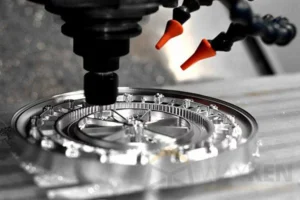Introduction
Selecting the appropriate machining process for “Manufacturing” is a crucial decision that depends on various factors, including the type of material, desired shape, and surface finish. Machining is a subtractive manufacturing process that involves removing material from a larger piece of raw material to create the desired shape or part. There are various machining processes available, each with its unique characteristics, advantages, and limitations. In this article, we will explore the different types of machining processes and help you determine which one to use for your manufacturing needs.
Types of Machining Processes
-
Turning : Turning is a machining process that uses a lathe to rotate the metal while a cutting tool moves linearly to remove metal along the diameter, creating a cylindrical shape. Turning is used to produce rotational, typically axis-symmetric parts with many features, such as holes, grooves, threads, tapers, diameter steps, and even contoured surfaces.
-
Drilling : Drilling is a machining process that uses multi-point drill bits to produce cylindrical holes in the workpiece. Drilling is used to create holes in various materials, including metals, plastics, and wood.
-
Milling : Milling is a machining method that uses rotating multi-point cutting tools to remove material from the workpiece. Milling is used to shape the workpiece, produce slots or grooves, machine flat surfaces, and create complex shapes.
-
Grinding : Grinding is a machining method that removes small amounts of material from both flat surfaces and cylindrical shapes. Grinding is used to produce high surface finishes, remove small amounts of material, and create precise shapes.
-
Planing : Planing is used to machine large flat surfaces, particularly ones that will be finished through a scraping process. Planing is used to generate accurate flat surfaces and cut slots.
-
Sawing : Sawing uses cut-off machines to create shorter lengths from bars, extruded shapes, etc. Sawing is used to cut various materials, including metals, plastics, and wood.
-
Broaching : Broaching is a machining process that uses a broach consisting of many teeth arranged sequentially to remove material from the workpiece. Broaching is used to create square holes, keyways, spline holes, etc.
-
Electric Discharge Machining (EDM) : EDM uses electric arcing discharges to create micro-craters that rapidly result in complete cuts. EDM is used in applications requiring complex geometrical shapes in hard materials and at close tolerances.
-
Electro Chemical Machining (ECM) : ECM is a reverse electroplating process that makes burr-free holes with high surface finishes. ECM is used for mass production and for working with extremely hard materials or materials that are difficult to machine.

Factors to Consider When Selecting a Machining Process
-
Material : The type of material you are working with is a crucial factor in selecting a machining process. Different materials require different machining processes. For example, EDM is used for hard materials, while ECM is used for materials that are difficult to machine.
-
Shape : The desired shape of the final product is another important factor to consider. Turning is used to produce cylindrical shapes, while milling is used to produce complex shapes.
-
Surface Finish : The surface finish required is also a significant factor. Grinding and EDM are used to produce high surface finishes.
-
Tolerance : The tolerance required is also an essential factor. EDM and ECM are used for applications requiring close tolerances.
-
Production Volume : The production volume is also a crucial factor. ECM is used for mass production, while EDM is used for low-quantity projects.
Conclusion
Selecting the appropriate machining process for manufacturing is a critical decision that depends on various factors, including the type of material, desired shape, surface finish, tolerance, and production volume. By understanding the different types of machining processes and their characteristics, advantages, and limitations, you can make an informed decision and select the best machining process for your “Manufacturing” needs. Remember, the right machining process can improve the quality, efficiency, and cost-effectiveness of your manufacturing process.
FAQs
-
What is machining?
Machining is a “Manufacturing” process that involves removing material from a larger piece of raw material to create the desired shape or part. -
What are the types of machining processes?
There are various machining processes, including turning, drilling, milling, grinding, planing, sawing, broaching, EDM, and ECM. -
What is the difference between traditional and non-traditional machining processes?
Traditional machining processes include turning, drilling, milling, grinding, planing, sawing, and broaching, while non-traditional machining processes include EDM and ECM. -
What is the purpose of machining?
The purpose of machining is to create something by removing metal from an object to shape it into something new. -
What are the advantages of machining?
Machining offers various advantages, including improved accuracy, increased efficiency






Leave a Reply